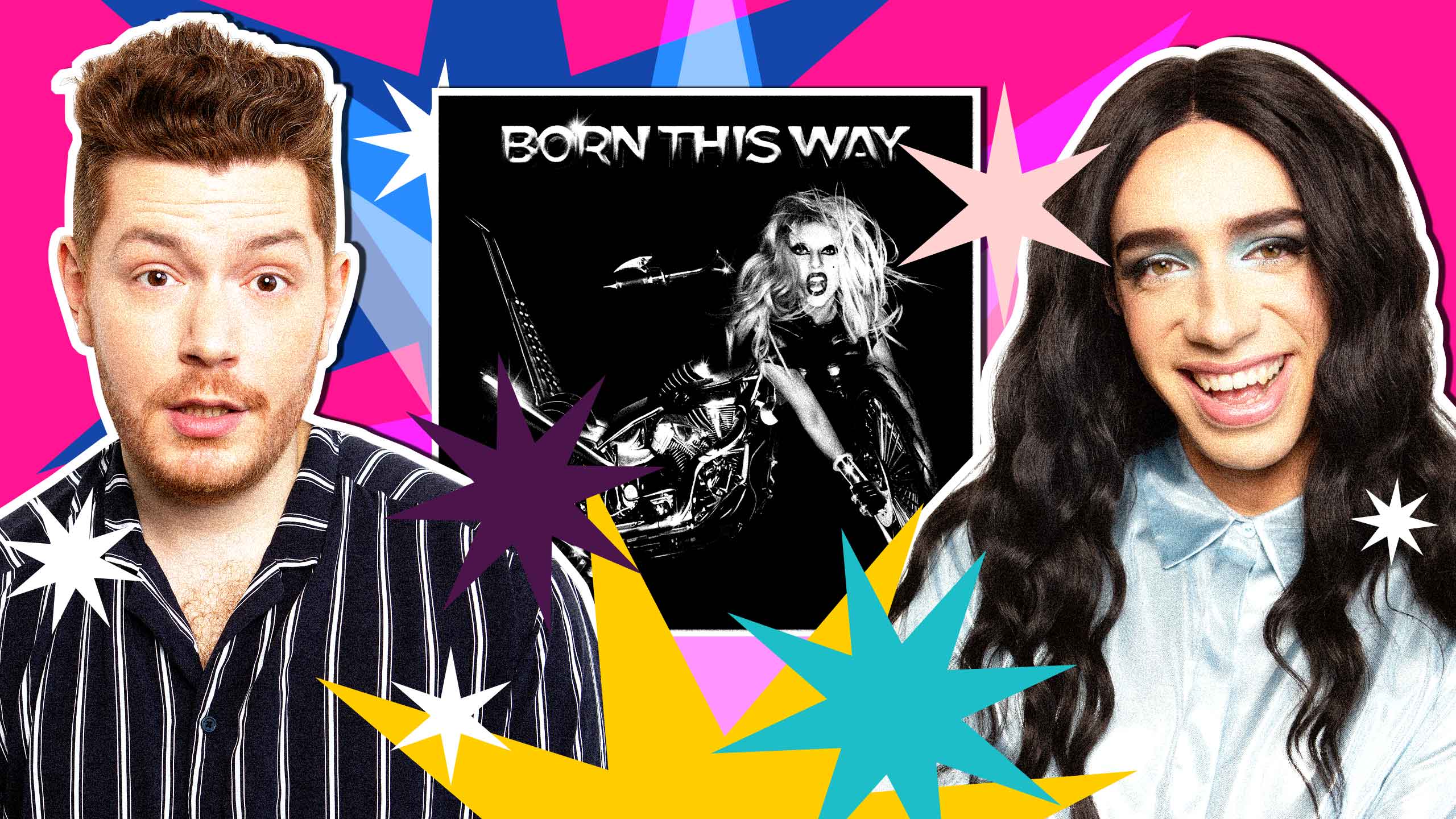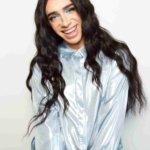It’s hard to believe, but we are celebrating the 10th anniversary of Lady Gaga’s Born This Way! Released internationally on May 23, 2011, the album went to number one in more than 20 countries, sold more than 6 million copies and spawned the mega hits “Born This Way,” “The Edge of Glory” and “You and I.”
In the lead-up to the album’s release, it is safe to say that Gaga was the biggest pop star in the world. Following a string of mega hits that defined their time—“Just Dance,” “Poker Face,” “Bad Romance”—the anticipation and expectations for Born This Way were sky high. When you reach that level of fame and success, a backlash is inevitable: When a pop star reaches a certain level of oversaturation, the media and the public want to destroy what they created. Gaga was fully aware of the knives at her back and told NME at the time: “I did a performance piece on this at the VMAs. I died and bled to death in front of everyone, because I suppose I thought if I died on stage and showed everyone what it looked like, they wouldn’t look for it. But they’re still looking for it.”
When “Born This Way” was released as the album’s first single, the backlash was almost immediate. The song drew negative criticism for being an alleged ripoff of Madonna’s “Express Yourself.” Madonna herself infamously called it “reductive.” Gaga’s response? “If you put the songs next to each other, side by side, the only similarities are the chord progressions. It’s the same one that’s been in disco music for the last 50 years. Just because I’m the first fucking artist in 25 years to think of putting it on Top 40 radio, it doesn’t mean I’m a plagiarist, it means that I’m fucking smart. Sorry.” Gaga was right.
“‘Born This Way’ was largely misunderstood at the time, but represented a major shift in the culture.”
Born This Way represents the simultaneous peak and decline of Gaga’s popularity. The album’s follow up, Artpop, is cheekily known on GayTwitter as Artflop. Gaga would spend a few years trying on different hats—including a pink cowboy one—until she found herself back at the top of the pop game with 2018’s A Star Is Born.
With Gaga’s pop queen crown firmly in place, now is the perfect opportunity to look back on Born This Way, an album that was largely misunderstood at the time, but represented a major shift in the culture. Through art and fashion, Gaga’s message of self-acceptance and self-love created a kind of safe space that allowed and encouraged a generation of queers to dare to be seen and heard.
Tranna: In 2011, I was the biggest Lady Gaga fan—a true Little Monster. Her previous albums, The Fame and The Fame Monster were my oxygen. I saw her tour, The Monster Ball, four times. I bought every magazine she was in, I could not have been more obsessed. In 2009, I dressed up as Lady Gaga for Halloween, and it was the first time since I was a kid that I allowed myself to express my femininity. It may sound ridiculous, but when I saw myself as Lady Gaga, it was the first time I really felt beautiful, and it was a turning point in my understanding of my transness—for that, Gaga will always be an important part of my life. I can’t even describe how excited I was for her new album—until I heard the title track, the lead single “Born This Way,” and I was so disappointed. I wanted to love it, but the message of queer empowerment felt so preachy and pedantic. It had the subtlety of hitting someone over the head with a rainbow-coloured baseball bat.
“The lyrics sound like a radio jingle for a recruitment campaign. Join the queers—they’re fun!”
Thomas: I mean, your story of self-discovery through Lady Gaga’s music is basically what the song’s straightforward lyrics are about. I love that it became a queer anthem, but it definitely had this LGBTQ2S+ for Dummies vibe: “No matter gay, straight or bi / Lesbian, transgendered life / I’m on the right track baby / I was born to survive.” Sounds like a radio jingle for a recruitment campaign. Join the queers—they’re fun! And all people talked about was the melodic and lyrical similarities with Madonna’s “Express Yourself,” not the content of Gaga’s song.
An element that I also found problematic in “Born This Way” is how queerness is only made acceptable because we’re born with it. It was daring to frame the nature versus nurture debate in a three-minute pop song. But if gender is a construct, it doesn’t make a lot of sense to advocate for equality based on people being born a certain way.
Tranna: I think it’s kind of cool that it’s the first song to have the word “transgender” in the lyrics, but other sections have really not aged well:
Whether you’re broke or evergreen
You’re Black, white, beige, chola descent
You’re Lebanese, you’re orient
Whether life’s disabilities
Left you outcast, bullied or teased
Rejoice and love yourself today
’Cause, baby, you were born this way
The song might as well be titled “I Don’t See Colour!”
Thomas: “Born This Way” is not my favourite Gaga song, but it signalled a shift in the culture. In 2011, same-sex marriage wasn’t federally recognized in the United States, and the conversation around gender wasn’t nearly as advanced as it is today. But ultimately, you’re right: “Born This Way” presaged the corporatization of Pride and queerness that we saw in the 2010s. Sure, it started earlier with branded floats in the 1990s, but social media brought it to a whole new level.
“What I loved about Gaga when she first burst onto the scene was her wacky irreverence, like the Kermit dress.”
Tranna: To me, the Born This Way album was the end of Gaga’s sense of humour and irony. Everything during that era was so heavy-handed, preachy, obvious and deeply unfunny. Gaga suddenly became the most annoying art student ever. What I loved about Gaga when she first burst onto the scene was her wacky irreverence—like the Kermit dress she wore and the way she would mess with journalists, telling them that the only thing she looks for in a man is a big dick. That was the Gaga I fell in love with. For Born This Way, she was replaced by an extremely pretentious Gaga who took everything way too seriously.
Thomas: After The Fame Monster and its massive singles—“Bad Romance,” “Alejandro,” “Telephone”—our girl Stefani had nowhere to go but down. These songs were too hip to be hits, but against all odds they were, and they made 2009 and early 2010 one of the most exciting times in pop music ever. She manifested the pop star that she wanted to be, which was such a powerful statement at the time. The iconic music videos, the Nicola Formichetti-styled looks, her bizarre award show performances—it all created massive expectations for what Gaga would do next. In just five years, she went from living in a dingy Lower East Side walkup to singing with Elton John at the Grammys! She made us all believe that our dreams were possible.
By 2011, she had become the kind of star that she would have been inspired by before. I think that messed up her point of view. She chased fame until she became fame.
Tranna: The real nail in the coffin for me was the Born This Way cover art. I think it is the ugliest, stupidest album cover of all time. On the cover, Gaga is half woman and half motorcycle—what did that image have to do with the message of the album? I remember praying that the album cover was a joke and that she was going to reveal the real album cover. Well, that never happened. The worst part is that the Nick Knight photoshoot for the album is sublime; the single cover for “Born This Way” is stunning and was instantly iconic. That photoshoot yielded some of the most interesting and gorgeous images of her career and she chose the fucking motorcycle picture for the album cover. I can never forgive her for that.
Thomas: Oh I agree, she was trying too hard to make that motorcycle moment happen. The album cycle actually went off the rails with the “Judas” music video and the apostles-as-biker-gang nonsense. It’s probably my least favourite Gaga song and video. It came out three weeks before the album release, which felt like an odd choice. Thank God she quickly followed up that mess with “The Edge of Glory,” but the damage was done.
Tranna: So much of the album is about being queer: It’s about accepting your queerness, celebrating your queerness, sharing your queerness with the world. Lady Gaga came out as bisexual early in her career, but has also called herself an “ally” and has publicly spoken about what it means to be a member of the community. I think this complexity is an interesting aspect of her work: What is queerness? What makes a person queer? Gaga’s queerness feels authentic to me. My favourite song on the album is “Hair,” which is about coming out to your parents and that you’re going to love yourself no matter what anyone thinks of you. It says so much more about what it means to be queer than “Born This Way.” But I must say that the video is fucking amazing.
Thomas: I don’t particularly like the “Born This Way” video—it’s a hot mess! There are so many ideas in there, from cheek prosthetics to her bizzaro mother-alien persona. It also featured Montreal’s own Zombie Boy (RIP Rick Genest), with his instantly recognizable tattoo-covered face. I actually interviewed him right after the video came out for a local magazine I used to work for. I believe I was the first journalist he spoke to about his experience with Gaga (yes, I’m bragging). And I remember being so attracted to him at the photo shoot. Wow, reminiscing about 2011—I really sound like a geriatric millennial. And FYI, Lady Gaga was only 25 years old when Born This Way came out. In comparison, Madonna was late to the party, releasing her first hit single at 25. Dua Lipa is 25 right now. It’s such an interesting age to be a pop star because you are still figuring out who you are. I can’t help but think the pressure is daunting.
Tranna: There was so much pressure for Born This Way to be a massive success. Gaga was the biggest star on the planet at that moment. She was everywhere. I remember reading and watching all her interviews at that time, and she kept going on and on about what a masterpiece the album was, that it was going to revolutionize music. She completely overhyped it and there was no way the album could live up to the hype. When it seemed like the album might not be the record-breaking smash it was expected to be,her label dropped the price to 99 cents on Amazon for two days to guarantee that the album would reach number one. That little ploy resulted in 440,000 copies sold for a total of one million in its first week. I remember feeling like it was kind of pathetic that they did that.
“If you’re going to put a telecommunications company logo on a T-shirt, it should be free.”
Thomas: OMG, record sales! How quaint to look back on the pre-streaming era. The pressure was also immense because Katy Perry had stolen Gaga’s thunder in late 2010 and early 2011 thanks to all of the consecutive number ones off Teenage Dream (“California Gurls,” “Firework,” “E.T.”). And in spring 2011, Adele was also taking over the United States with 21, which became the best-selling album of the decade. That’s the context in which Interscope was launching Born This Way on May 23, 2011.
Tranna: I reluctantly went to go see the tour for the album, The Born This Way Ball. While I had a great time, I didn’t listen to Gaga anymore for a long time afterward. I was completely over her. At the show, there was advertising for Skype and Virgin Mobile everywhere. I know pop is a corporate endeavour and that all pop stars have major endorsement deals, but this was next level. Even the T-shirts she was selling had Virgin’s logo on them. If you’re going to put a telecommunications company logo on a T-shirt, it should be free. I remember feeling so repulsed, like she had totally co-opted this message of queer empowerment, self-love and acceptance and sold it out. She lost all credibility to me.
Thomas: Wow, she really fell off the pedestal for you! I liked the album at the time and I still find some humour in it. I mean, her fake-German bop “Scheiße” is so kooky, it’s like a sketch with Bowen Yang on SNL. It’s ridiculous and it works! To me, the best moments on her albums are when she feels no pressure and she can just be a basic Europop girl. “Government Hooker,” “Black Jesus + Amen Fashion,” “Electric Chapel”—these were for the Little Monsters. Some lyrics are terrible, and the production borders on demo-like Casio cheapness, but that’s the Gaga sound she perfected early on with producer RedOne. She doesn’t overthink: She can write multiple songs about European fashion shows while going full-on country blues on “You and I,” and close the album with the most epic sax solo of the 21st century on “The Edge of Glory.” I love that she had Springsteen’s sax player Clarence Clemons on the track; it shows that, at the end of the day, she is committed 100 percent.
Tranna: And that she really knows her shit. Now, 10 years later, I think the album is brilliant. At the time it was a huge disappointment because of all the hype and her pretentiousness, but now that I can listen to the album without any of the noise surrounding it, I can see that it is a pop masterpiece.
“I know pop is glossy and superficial by nature, but to me, mainstream pop today has really lost its soul.”
Thomas: This is for another column, but even then-panned Artpop has surprisingly aged well. I love how fans are pushing for the album to be rehabilitated because it was labelled a flop when it actually wasn’t.
Tranna: It was a flop compared to her previous success. Flops are always relative: Madonna’s Erotica was considered a flop, even though it has sold more than 6 million copies worldwide.
Thomas: Being a queer pop fan is so much fun because we get to dissect these moments for years and years and centre our identities on how we feel about certain albums.
Tranna: I don’t see many albums like Born This Way being made anymore, and it makes me sad. It feels like the art of the album is a dying one. In the age of Spotify and algorithms, artists are releasing songs that are literally two minutes long because all the industry seems to care about are numbers, and a song that’s two minutes long can be streamed five times in 10 minutes, whereas as a five-minute song can only be streamed twice in 10 minutes. If it’s less than two minutes and 30 seconds, I’m sorry, but it’s not a song. I know pop is glossy and superficial by nature, but to me, mainstream pop today has really lost its soul, and I don’t care if that makes me sound like I’m 50 years old. Gaga is the only contemporary artist who is on the level of the greats. She is the last true superstar.
Thomas: She is! She is our generation’s Great. Baby boomer queers had Barbra, Gen X grew up with Madonna and we have Gaga. Born This Way was also the template for what was to follow: The fame hangover on Artpop, trying to be rock ’n’ roll on Joanne and the A Star Is Born soundtrack, then circling back to ecstatic space pop on Chromatica. She takes us on a journey and believes in her own fantasy.
Tranna: Here’s what I think is Born This Way’s legacy: It allowed pop music to be queer again. While it definitely wasn’t easy to be an out artist in the ’60s, ’70s, ’80s and even ’90s, those decades had their queer icons: David Bowie, Boy George, Klaus Nomi, Freddy Mercury, k.d. lang, Linda Perry and Melissa Etheridge to name a small handful. But pop culture in the 2000s was extremely heteronormative. The biggest female stars of that time—Britney, Christina, Destiny’s Child, Jennifer Lopez—were serving us hyper male-gaze femininity, as the male stars were serving hyper masculinity (a.k.a.. homophobia). I was a teen at that time desperately searching for queerness in pop, but it was nowhere to be found. There were no mainstream pop stars playing with queerness or gender-bending. (Sorry, but Britney and Madonna’s kiss does not fucking count.)
When Lady Gaga came on the scene, she totally flipped the script. She channelled all the queer icons of the past, opening the doors for so many of us to express our queerness in a way many of us didn’t think we would ever be able to.
Montreal-based comedians Thomas Leblanc and Tranna Wintour’s podcast Chosen Family streams on CBC, Apple and Google; new episodes drop every other Thursday.
Correction: May 24, 2021 2:01 pmAn earlier version of this story identified Lady Gaga as straight. She came out as bisexual in 2009. The text has been updated to reflect that.



 Why you can trust Xtra
Why you can trust Xtra


